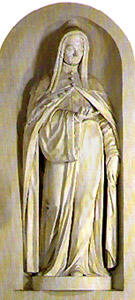
Doge Cav. Proc. Marco Cornaro (SA-51/B-1)
Born: 1286 [prob.]
Married: (1) c. 1305, Giovanna Scrovegni; (2) Before 1336, Caterina _____
Died: 13 January 1368
DOGE CAV. PROC. MARCO CORNARO, the 57th Doge of Venice, was the first of four Doges elected from the Cornaro family. The Doge [Duke] was the leader of the Venetian government, elected by the patriciate to hold office for life. Marco's election came at the end of a long military and diplomatic career, and he died after just three years in office.
Although the record is not clear, Cornaro seems to have begun his eventful career by taking a degree in law at the University of Padua. In any case, his cultural interests are evidenced by the unusual fact that he owned a personal library at the time of his death.
In the Venice-Scaligera War, 1336-9, he was joint commander of an allied force that drove to the suburbs of enemy-held Padua, 16-28 October 1336. He served as Podestà [governor] of Padua, 1337-8; Count of Zara [in Dalmatia], 1344-45; Duke of Candia [Crete], 1347-8. During the Third Venice-Genoa War he was assigned important military and diplomatic duties, including appointment as one of four Provveditore all'armata di mare [civil commanders of the fleet], 1352.
In one important diplomatic triumph, Cornaro was appointed joint Venetian ambassador to Louis, King of Hungary, to resolve Hungary's demand that Venice return Zara and Dalmatia. Louis threatened to ally with Genoa in its war with Venice in retaliation for Venice's alleged violation of the Treaty of 1348. The ambassadors succeeded in arranging for the dispute to be settled by Charles IV of Luxemburg, who soon became Emperor of the Holy Roman Empire. Cornaro and his co-ambassador participated in the reconvened Parliament of Vienna, 1354, and were created Knights of the Holy Roman Empire by Charles IV, 1354. In November of the same year Cornaro was part of a legation sent to Mantua to outline to Emperor Charles IV a Genoan peace proposal.
In 1355 the senior nobles of Venice discovered a plot by Doge Faliero to seize complete control of the government. The nobles met secretly at Cornaro's house in the Parish of S. Felice to plan their counter-measures. After Faliero had been arrested and executed, Cornaro was selected to rule as Vice Doge in the brief interval before a successor Doge could be elected.
In another incident of high danger, Cornaro was again dispatched on a mission to the court of Charles IV, 1359. While returning to Venice, January 1360, the diplomatic party was captured and imprisoned by Rudolph, Duke of Austria, who sought reimbursement for a castle destroyed by Venice in its war with Hungary. Cornaro was not freed and returned to Venice until September 1361, 19 months later.
In January 1383, following service as ambassador to Pope Urban V at Avignon, Cornaro was named Procurator de Supra. At last, 21 July 1365, Cornaro was elected Doge of Venice, overcoming four objections raised by his political opponents: that he was too old, that he lacked sufficient wealth, that he had ties of friendship with foreign princes, and that his wife was not from a noble family. (His first wife was the daughter of Enrico Scrovegni of Padua; his second wife was from a prominent Dalmatian family.)
In his brief tenure as Doge he reestablished commercial relations with Egypt, interrupted since 1356, by successfully prevailing upon Pope Urban V to revoke his prohibition on dealing with infidels. He initiated construction of the wing of the Palazzo Ducale [Doge's Palace] toward the basin of S. Marco and commissioned decoration of the Chamber of the Consiglio Maggiore [Grand Council].
Doge Cav. Proc. Marco Cornaro is one of four Doges buried in the main choir chapel of the Church of SS. Giovanni e Paolo [Zanipolo]. His funeral monument is a statuary group by Nino Pisano that Cornaro himself commissioned prior to his death.
© 1997 C. I. Gable
